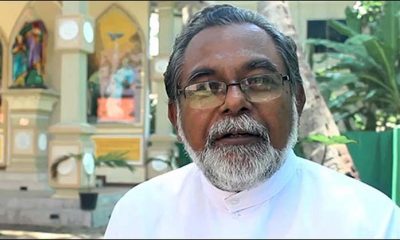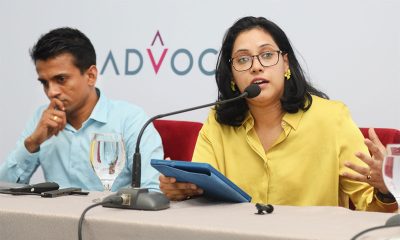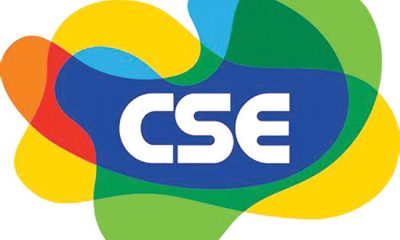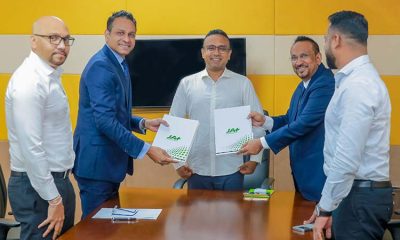Business
Import ban on inorganic fertilizers and its effects on the tea industry

by Devaka Dias
1. Vegetatively Propagated Teas are CLONAL HYBRIDS which requires high and correct nitrogen ratios to reach its potential yield of over 3,000 kg per hectare made tea per annum.
2. The required norm is 10 kg nitrogen for every 100 kg of made tea. If soil carbon ratios are good at 7% organic matter in the soil, improving the cation exchange (ability of soils to hold nutrients) capacity, it is possible to reduce the N ratio from 10 N to seven N per 100 kg made tea. However, timing and the method of application is very important to derive absolute benefit.
3. Most soil where tea is grown in Sri Lanka is eroded and the organic matter in the soil is so poor that the tea is fertilizer dependent.
4. A field yielding 3,000 kg of made tea per hectare will require 300 kg N. Less if the soil carbon is good. The N per one ton of compost is believed to be low at 1.5% nitrogen. Based on this, one hectare of tea yielding 3,000 kg per hectare will require 20,000 kg of compost each year. Cost of procurement and application will be prohibitive and not cost effective and practical.
5. The quality of compost supplied to the industry requires to be closely monitored, particularly if imported, as there is the risk of introducing nematodes and other pest and diseases that we did not have hitherto.
6. Where compost is produced locally, proper C:N ratios must be ensured to give a standard of 20:1 or below. Quality control is a must or there will be repercussions as with high ratios the bacteria in the compost will draw nitrogen from the soil.
7. Compost fertilizer will be unable to match nitrogen, phosphate & potassium ratios recommended by the TRI. For example if the potassium levels are too high, it will bring about a magnesium deficiency making the leaf yellow.
8. If nitrogen is reduced, production will take a huge dip and leaf supplied to the factory will not be healthy for producing good tea. Succulent leaf is required for good tea manufacture but with less nitrogen the leaf will be yellowish and leathery. This will result in a brownish tea and high percentage of off grades. Poor quality tea will not fetch good prices at the auctions and the overall average will dip with both the factory and the green leaf supplier severely affected. The tea factories will run into problems of not being able to achieve the desired out-turn from green leaf to made tea which should be 21.50%. Even a loss of 0.50% will mean a loss to the factory in monetary terms which they can ill afford. A tea factory manufacturing 500,000 kg of green leaf based on a green leaf rate of Rs.100/= per kilo, incurring a loss of 0.05% on the out-turn will incur a loss of Rs.250,000/=.
9. The reduction of nitrogen over a long period of time will weaken the tea bush and the casualty rate will be very high after pruning.
10. Dependence on artificial fertilizer can be reduced but not completely stopped. Reducing the current rate of application cannot be done overnight and must be implemented in stages at the grower level. I suggest the following steps:
a. Encourage the grower to establish Gliricidia and Albizzia shade and maintain it correctly. A good cover of both type of shade ensures improving the soil carbon over a period of time. Fifty kg of gliricidia leaves adds 01 kg nitrogen into soil. In land with a high gradient, de-silting of drains is a must.
b. In land with a poor cover of tea due to erosion, most of the soil carbon will be lost and the grower must be encouraged to infill. Bright sunlight falling directly on the soil burns up soil organic matter very fast and also leads to the loss of ammonia in the soil when the soil temperature increases. Therefore establishing shade and infilling vacant tea patches is essential.
c. By changing the method of fertilizing, efficiency can be improved. Currently, the method of fertilizer application is to apply the manure on the surface of the soil by what is popularly known as broadcasting. This, I consider, to be the most inefficient method of application leading to loss of ammonia. I have over a decade adopted a different method of placement of fertilizer.
While this is expensive, it successfully reduces the volume of fertilizer that need be applied. The fertilizer is placed in a 6-inch deep alavangoe hole, one and a half feet away from the bush on the upper side of the slope and the hole covered. The cost of placement works out to three and a half workers per acre as opposed to one when broadcasting. It is a crime at today’s cost to waste fertilizer by broadcasting using more volume than necessary to compensate for volatization. More so as there is a big government fertilizer subsidy.
R & D is required to invent an applicator for fertilizer placement.
In conclusion I must say that with good agricultural practices, dependence on artificial fertilizer can be reduced but we cannot go 100% organic. It is important to educate tea growers, 70% of whom are smallholders using very much more than recommended doses of fertilizer, to mend their ways. They believe that applying more fertilizer means overnight crop increases and make five or six applications when four would suffice if correctly timed. What the smallholder does not understand is that we have to only replace N that has been removed from the soil. This is why we go on a replacement ratio of 10 kg N to 100 kg of made tea which could be reduced to 7% if the soil organic matter is good.
If a study is done on the fertilizer use by the smallholder and N replacement ratio worked out, I am sure the figure will be astronomical. This is where lot of money is wasted and must be corrected. With proper use of fertilizer, imports can be reduced and valuable foreign exchange saved by the country.
The authorities must also develop a method of issuing fertilizer to smallholders based on their production. This should not be a problem as the factories have the required information. In my opinion four application of fertilizer is more than enough with application during and after the two monsoons when the assimilation is best.
Reducing rate of N application with artificial fertilizer, in my view, does not require addition of compost if proper agricultural practices are followed. In an estate I work on, the soil is very rich in organic matter on account of a good cover of Albizzia and Gliricidia. No soil is exposed to direct sunlight as a lot of Albizzzia leaf litter and twigs and gliricidia loppings lie on the soil. They slowly disintegrate into colloids that will attract a negative iron to bind the ammonia and other elements such as Pottasium, Calcium etc.
I appeal to the authorities to rethink the ban on inorganic fertilizer imports. Immediate change will cause a lot of hardships to the grower, particularly the smallholder who contributes 70% to the national production and depend on this income for a living. The grower requires to be educated on the importance of soil organic matter to get them to adopt correct agricultural practices and reduce dependence on artificial fertilizer.
Halting inorganic fertilizer and moving totally to organic will cause irreversible damage to the industry in many ways. What is required is to improve the soil organic matter and reduce the dependence on fertilizer. One has to keep in mind that the tea industry is an interconnected web and the ban will not only affect the grower and the factories but also many others indirectly employed in the tea industry.
(The writer is a senior planter from a planting family with 48 years experience in the industry.)
Business
Urgent appeal from Sri Lankan exporters on rupee appreciation

As a collective body of exporters, we have been at the forefront of sustaining employment and ensuring a steady flow of foreign exchange, even amidst the most severe economic downturns faced by our nation. Our membership covers the majority of merchandise exports, which account for some 13% of Sri Lanka’s GDP. Today, we stand united in urging the authorities to address the pressing challenges posed by the appreciation of the Sri Lankan rupee (LKR) against the US dollar (USD), further compounded by restrictions on the movement of foreign currency between commercial banks, and the mandatory conversion of export earnings into Sri Lankan rupees, a number of local organizations prominent in the field of exports said in a joint statement.
The organizations concerned are; the Exporters Association of Sri Lanka, National Chamber of Exporters, Sri Lanka Association of Manufacturers and Exporters of Rubber Products, the Joint Apparel Association Forum of Sri Lanka and the Tea Exporters Association.
Extracts from the statement:
‘The appreciating rupee has had a multifaceted negative impact on our business. A stronger rupee means our goods become more expensive for international buyers, directly affecting our competitiveness in the global market. The exchange rate peaked at over Rs. 364 per USD in May 2022, which led to increased operational costs, compelling us to adjust our cost base in line with higher inflation experienced in the country. The rapid appreciation of the rupee, with rates falling below Rs. 300 per USD since March 19th, has placed us in a precarious position, threatening the sustainability of our businesses and the livelihoods of those we employ. Despite the appreciation of the rupee, the cost of living remains high, continuing to level pressure on worker wages.
‘The timing of the rupee’s appreciation coincides with weak global demand for the majority of our merchandise exports and severe competition from competing countries. Factors such as global inflation and geopolitical tensions have continued to affect sentiment and purchasing power in the primary markets of our merchandise exports.
‘The painful economic stabilization process implemented with significant monetary and fiscal policy measures by way of policy rate, inflation, and tax adjustments; import controls; and debt service suspension, has had the desired impact to constrain economic activity and, in turn, adjust and constrain import demand. At the same time the collective efforts of the government, export community, tourism industry and remittances have continued to have a positive inflow and enhance foreign reserve positions to more comfortable levels.
‘This is in the backdrop of the extraordinary circumstances when the debt servicing by the country remains at a standstill, which is a temporary situation.
It is crucial to recognize that the landscape of our foreign exchange reserves has significantly transformed and the continued enforcement of the mandatory conversion policy, considering the current positive reserves, is counterproductive. Persisting with this approach has placed exporters at a market disadvantage and forced them to operate on an unleveled playing field, eroding their competitiveness. It further acts as and is viewed as an anti-export policy measure. Export-led recovery needs to be prioritized to ensure the inflow of vital export earnings and to encourage investments in the future.
‘In light of these considerations, we urgently request the Central Bank to revisit and repeal the aforementioned Gazette, in alignment with the evolving economic context. This appeal is made with a vision towards fostering an environment that not only enables but actively supports the growth and competitiveness of Sri Lanka’s exports. By addressing these policy concerns, we can lay the groundwork for sustainable economic development, secure employment for our citizens, and ensure the continued prosperity of our nation.
‘We invite the government of Sri Lanka to join us in taking decisive action towards these ends. Together, we can chart a course towards a brighter, more resilient future for the Sri Lankan export sector and, by extension, our economy at large.’
Business
ADL Wins GLOMO at MWC Barcelona, Makes History as Inaugural Recipient of Open Gateway Challenge
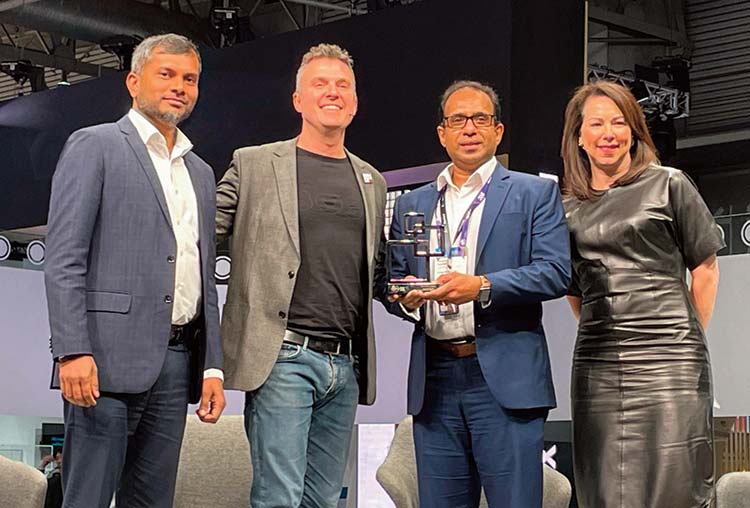
Axiata Digital Labs (ADL) proudly announces its first win at the 29th annual Global Mobile (GLOMO) Awards held during the recently concluded Mobile World Congress (MWC) in Barcelona. ADL secured the Open Gateway Challenge GLOMO Award, a new category in 2024, marking a significant milestone in the company’s journey as a leader in digital innovation and connectivity solutions, enabling telco-to-techco journey with their Axonect Telco Fabric.
The award recognizes ADL’s exceptional contribution to the mobile ecosystem through the MetaStage platform powered by Axonect Telco Fabric. Leveraging GSMA’s Open Gateway APIs, ADL demonstrated remarkable innovation in simplifying integration across two operators, Dialog (Sri Lanka) and XL Axiata (Indonesia). The MetaStage platform facilitated a groundbreaking metaverse concert, showcasing the immense potential of GSMA’s Open Gateway initiative to engage diverse customers across borders and drive new revenue opportunities for operators.
(Axiata Digital Labs’ CEO, Thushera Kawdawatta, and CTO, Namal Jayathilake, receiving the first-ever Open Gateway Challenge Award at the Annual Global Mobile (GLOMO) Awards at Mobile World Congress in Barcelona)
ADL stands at the forefront for GSMA Open Gateway innovation, pioneering the empowerment of developers and enterprises through universal access to network operator APIs. GSMA’s Open Gateway initiative, is poised to revolutionize connectivity by democratizing access to these essential APIs via the Linux Foundation’s CAMARA project. As the inaugural recipient of the Open Gateway Challenge GLOMO Award, ADL’s commitment to innovation and collaboration underscores its pivotal role in driving transformative change within the industry. With a focus on open standards and strategic partnerships, ADL continues to lead the charge in shaping the future of connectivity and unlocking new opportunities for digital innovation.
Dr Hans Wijayasuriya, Group Executive Director and CEO of Telecommunications Business, Axiata and Chairman, Axiata Digital Labs said, “It is a great source of pride to Axiata that ADL, our multi-country Software and Digital Transformation unit has won the GLOMO – Open Gateway Challenge. Axiata was an early signatory to the Open Gateway MoU of the GSMA and this accolade reaffirms our commitment to transforming the role of Telcos through innovation centered on APIs and Eco-Systems.
The award also reaffirms our belief in the power of open collaboration and underscores our commitment to establish federation and interworking between Telcos via the Open Gateway, and to reach out to developer and content creator eco-systems to create consumer experiences of the future – in this case a Metaverse experience spanning multiple markets and audiences. ADL will no doubt continue to push the boundaries of what’s possible with the Open Gateway and more generally through API orchestration, and thereby continue to lead the best practice in Telco-TechCo Transformation”
Thushera Kawdawatta, Chief Executive Officer of Axiata Digital Labs expressed, “We’re honored to win the Open Gateway Challenge GLOMO Award at MWC24 Barcelona! This prestigious recognition validates our dedication to developing Axonect, a groundbreaking telco fabric that’s transforming the digital landscape. Our collaboration with Dialog and XL, powered by Axonect, exemplifies the power of GSMA’s CAMARA initiative.
It fosters industry-wide innovation and synergy, unlocking the true potential of telco asset monetization. Axonect empowers businesses to collaborate and leverage standardized APIs, maximizing speed to market and accelerating innovations. As the Axonect Open Gateway solution, we’re confident in shaping the future of connectivity, and it will unlock long-term growth for businesses worldwide.”
Business
Janashakthi Life records highest ever PBT of LKR 5.2Bn.
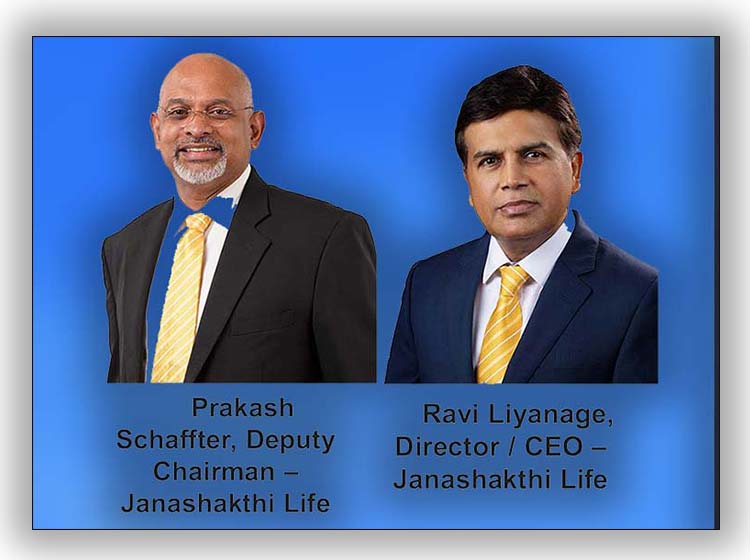
Janashakthi Life, one of the leading life insurance companies in Sri Lanka, has recorded remarkable growth in profitability for the financial year 2023. Marked by a record profit before tax of LKR 5.2 billion, along with a resounding growth of 201% in profit after tax compared to 2022. This achievement is the highest in the entire history of Janashakthi Life. It underscores the company’s robust financial health and strategic proficiency in navigating market challenges.
The key financial indicators, such as a Capital Adequacy Ratio of 272%, a Liquidity Ratio of 3.9 times, an ROE of 27%, Earnings Per Share of LKR 18.25, and LKR 3.4 billion in claim settlements, solidify the prudent financial management from the perspective of all stakeholders.
“One of the key factors that contributed to Janashakthi Life’s success during the year under consideration has been our proactive approach to managing market risks, particularly in anticipating and navigating interest rate fluctuations. We accurately anticipated the dynamic behaviour of yield curve movements, allowing it to strategize its balance sheet accordingly. These strategic decisions have positively impacted the achievement of a historic highest profit before tax of LKR 5.2 billion,” commented Ravi Liyanage, Director/CEO of Janashakthi Life.
He further stated, “Despite market challenges, our focus on prudent investments and timely actions taken to mitigate risks in the business has positioned us to achieve continued success and significant growth in all our key business performance indicators.”
Prakash Schaffter, Deputy Chairman of Janashakthi Life, added, “The year under review stands out as one of our most successful. We have once again reinforced investor returns with the company achieving a remarkable 201% growth in Profit After Tax, amounting to LKR 4.1 billion. Strong financial discipline and swift decision-making in the investment front have paved the way for substantial and stable returns.”
-

 Business1 day ago
Business1 day agoCEAT Kelani launches 3 new radial tyre variants in ‘Orion Brawo’ range
-

 Business3 days ago
Business3 days agoSOEs seen as failing SL’s ordinary citizens
-

 News4 days ago
News4 days agoSay no to NEPF! Say no to abolishing free education!
-

 News7 days ago
News7 days ago123rd Birth anniversary of Dr S A Wickramasinghe commemorated
-

 Business1 day ago
Business1 day agoDialog-Airtel Lanka merger comes centre stage
-

 Midweek Review3 days ago
Midweek Review3 days agoBetween abstraction and empathy in Sarath Chandrajeewa’s visual paraphrases
-

 Business1 day ago
Business1 day agoSLFEA appoints JAT as a Facilitation Partner for training painters to provide overseas employment opportunities
-

 Latest News4 days ago
Latest News4 days agoFormer Member of Parliament Palitha Thewarapperuma passes away










